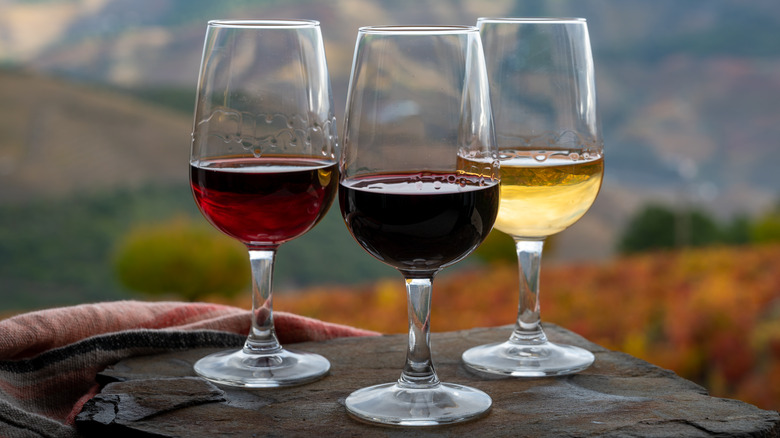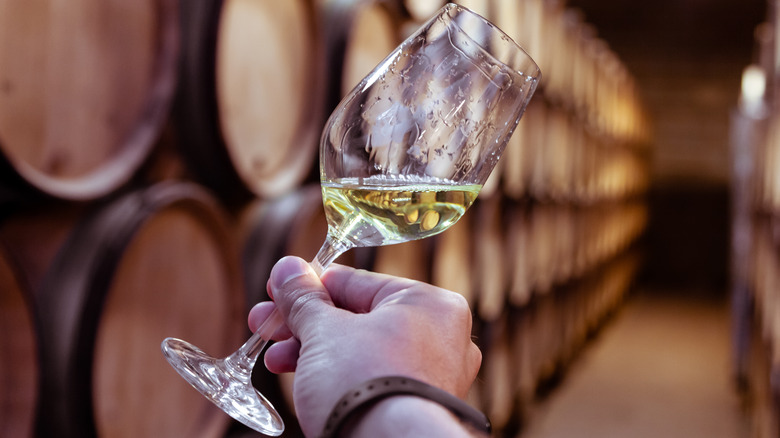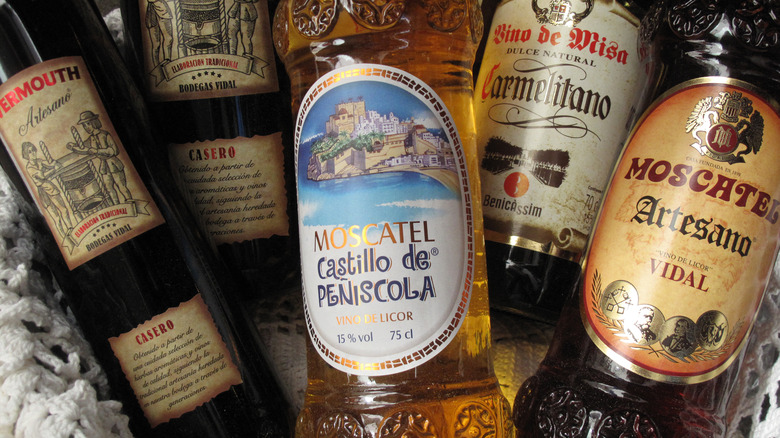Here's What It Means When A Wine Is Fortified
Fortified wines have gotten a bad rap in certain circles. "People associate fortified wines with cheap quality and sort of lesser-made products," as bar manager Lee Carrell told Eater. But this presumptuous perspective rather misses the point.
You aren't supposed to approach fortified wines in the same manner you do regular wines. They are so wholly distinct that they must be viewed as unique products with special characteristics and capabilities, and they are suited to different applications and occasions. Fortunately, it seems the public perspective has started to shift in a more positive direction over recent years, as makers of fortified wines have worked to raise awareness of their products' true nature. Yet, the problem remains that many people aren't even certain what fortified wine is.
In simple terms, fortified wine is a blend of wine and spirits. Wine is made from the juice of fermented fruits, most commonly grapes, while spirits (also called liquors) are made by fermenting material such as grains and distilling the results. Distillation entails heating an alcoholic mixture until all the alcohol evaporates, then capturing that vaporized alcohol and condensing it in isolated form, making spirits far more concentrated than wine in terms of alcohol by volume — A.B.V. While there's a whole world of fortified wine varieties, they're all based on the same concept: strengthening wine through the alcoholic power of distilled spirits.
What 's the appeal of fortified wine?
Regular wine has an A.B.V. ranging from 7% to 13%, while spirits are much stronger, running from 40% to as much as 90%. Adding spirits to wine gets you to a point in the middle, giving fortified wines an average A.B.V. of around 17% to 20%. There's an obvious appeal here to certain people, but the practice of fortifying wine actually arose from practicality.
Prior to the advent of fridges, shipping wine long distances — particularly overseas — was an absolute nightmare. Wine casks are not airtight, and with enough exposure to air, wine will eventually become vinegary as it oxidizes. Since alcohol itself won't expire, increasing the alcohol content of the barrels can keep them from spoiling, and this was the initial motivation for adding spirits to wine.
Fortifying wine also has a profound effect on its flavor, depending on the wine and spirits used as well as the manufacturing process. Fortified wines tend to be sweeter than regular ones. This is because, during the winemaking process, the natural sugars in grapes are gradually converted into alcohol; however, spirits are added to the mix before the wine is done fermenting, leaving the drink in a sweeter state.
Fortified wine may also have herbs, spices, or other ingredients added for flavor, which would make it an aromatized wine. Today, different types of fortified wine are subject to regulations on A.B.V., the aging process, other additives, and the kinds of wine and spirit involved.
Fortified wine types
Fortified wine is a broad category containing many subvarieties with unique production processes. Sherry, which comes from the Andalusia region of Spain, consists of wine fortified with a neutral grape spirit. The wine may be sweet, made from moscatel or Pedro Ximénez grapes, or it may be dry, made from palomino grapes.
The most distinct aspect of sherry is the solera aging process. Sherry is aged in a series of barrels, none of which are ever drained completely. Instead, when the oldest barrel comes of age, about half of it is poured out for sale. Then, the barrel is topped off with half the contents of a younger barrel, which is in turn topped off by another younger, barrel, and so on.
Vermouth, on the other hand, is an aromatized wine. So, it's fortified not only with a spirit – the exact type can vary – but also with herbs and spices. The characteristic flavoring in vermouth comes from artemisia, aka mugwort.
Other types of fortified wine include the well-known Port, which has a signature sweetness, usually owing to added brandy. It originated in Portugal, as did two other popular versions of fortified wine: Madeira and moscatel de Setúbal. Madeira is similar to Port, but it's aged in a heated environment, either via hot water, steam, or sun. Moscatel de Setúbal has grape skins added to the wine after the distilled spirits, giving it a funky flavor. No two fortified wines are quite alike.


